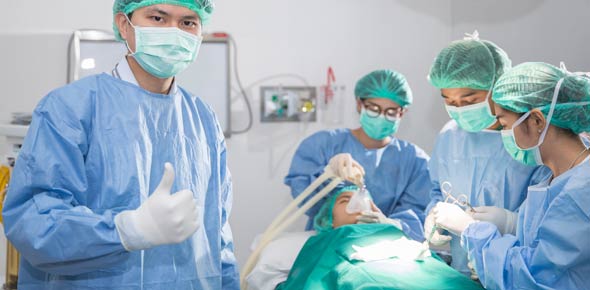A forcep used in nasal surgery is a (n)
Complications can occur during endoscopy, such as
When using a fiberoptic, burns and fires are prevented by
Which instrument is a retractor?
The Bookwalter is a ____________ instrument.
When suctioning in neurosurgery a precaution taken is to
A neuro headrest skull clamp is called a (n)
An endoscopy procedure that does not require a sterile set up is
A regional block that used the tourniquet is a (n)
All of the following instruments can be found on a nasal setup EXCEPT
At what point should the surgeon be informed of the time of tourniquet...
Stone forceps on a kidney set are
Why are only moist sponges utilized during electrocautery use?
Which graft must be obtained with a dermatome?
All of the following can be found on a tonsillectomy setup EXCEPT
The tourniquet is contraindicated if
A sterilant that is used on endoscopes that is bactericidal,...
A central venous pressure (CVP) catheter insetion requires
Fiberoptic cable integrity is questionable when
When using a cellsaver for autoogous blood transfusion, the blood is...
A cautery would not be used
Exsanguination of a limb before tourniquet inflation is accomplished...
When would the use of Esmarch be contraindicated?
Which condition is MOST acceptable when using electrocautery?
The proper setting for a tourniquet applied to an arm is
The fracture treated with arch bars is
Which suction tip has an angle and is used in the mouth or throat?
The power source for the Air Drill 100 is
The following statements regarding a grounding plate for...
If the electrocautery is used through the colonoscope, carbon dioxide...
Which procedure requires a sterile setup?
Why must the electrocautery tip be kept clean?
Rib removal for surgical exposure of the kidney requires all of the...
Disintegration of kidney stones through a liquid medium is...
The power source for air-powered dermatomes is
The suction tip that is right angled and used for small amounts of...
A Furlow inserter is used in
A ____________ is a mounth gag.
In what surgery would a small fragment compression set be used?
A precaution necessary when using a pneumatic tourniquet is
On which case would a boomerang be found?
During orthopedic surgery the suction tubing should be
A grounding pad is not required for the electrocautery in
Fulguration is utilized primarily in ___________ surgery.
Skeletal traction of a lower leg is accomplished with the use of a (n)
In orthopedic surgery, the viewing of the progression of a procedure...
The purpose of a set of Bakes would be
A direct visualization of the common bile duct is done by means...
Which item is an air drill?
The most frequent conditions requiring the use of a permanent...
Which setup would include a Gomco clamp?
On which setup would either a Pereyra or a Stamey needle be found?
The active electrode on the electrocautery is the
A neurosurgical drill used for precision cutting, shaping, and repair...
When working in the bladder why is more or higher electrical current...
A bougie is a
Tissue expanders are used in
On which setup would a Beave knife handle be found?
Which statement is true regarding a STERIS system for endoscope...
On which setup would bougies be found?
Traction applied directly on bone via pins, wires, or tongs is
A tourniquet is utilized
An instrument used in laparoscopy to manipulate the uterus for...
Each of the following steps can assist in the immedicate determiation...
Which type of surgery would require several patent suction cannulas...
A neurologic study in which a radiopaque substance is infected into...
A permanent pacemaker operates on a pulse generator powered by
In which procedure would a tourniquet be contraindicated?
The inactive electrode of the cautery is the
A Cavitron unit is used for
Which action drains venous blood during tourniquet application?
Which item would not be included on a setup for a transvenous...
Which movement in a power instrument drills holes or inserts screws,...
A Steffee plate is a
In which surgical specialty would a Humi Cannula be used?
A long thoracic forceps is a
Which procedure would utilize a Mason-Judd retractor?
The amount of pressure used to inflate a tourniquet depends on all of...
Which setup would include distraction and compression components?
The power instrument that is small, light weight, free of vibration,...
A urology perineal retractor system is called
A Sarot is a
The electrical circuit of the electrocautery when
In electrosurgery, "buzzing" refers to
An economical, practical, and effective way to clean reusable...
Fiberoptic lighting is
A craniotomy may employ the use of a (n) ___________ for exposure.
Which electrosurgical unit provides precise control of the coagulated...
Specialized instruments for a cleft lip repair would include
Cloward instrumentation would be included for surgery of the
Skeletal traction is accomplished with
Hypothermia is employed in cardiac surgery
The power source for Hall power equipment is
Fulguration via the resectoscope is accomplished by the use of a...
A Millin is a (n)
Which item is not a component of a cardiopulmonary bypass system?
Maintenance of acceptable blood pressure and prevention of the...
Which agent is NOT sed to inflate a pneumatic tourniquet?
Suction tubing should be processed in the following way
All are precautions when handling fiberoptic cables EXCEPT

















